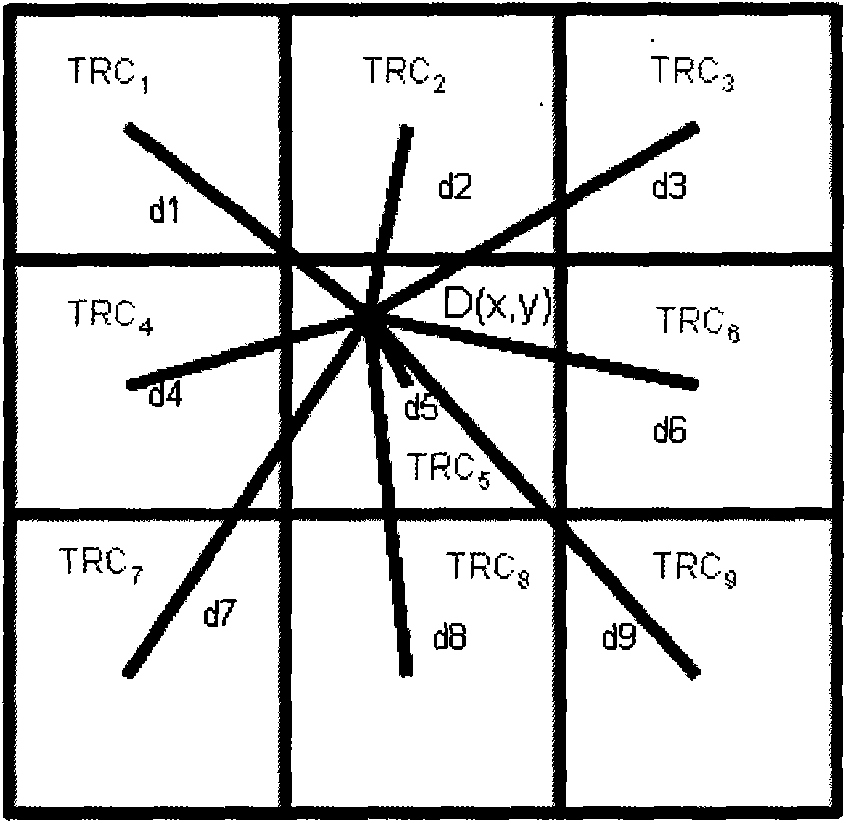Methods for matching dynamic range of image signals
A dynamic range and image signal technology, applied in image communication, color signal processing circuit, color TV components, etc., can solve the problems of poor dynamic range matching and affecting image quality, etc.
- Summary
- Abstract
- Description
- Claims
- Application Information
AI Technical Summary
Problems solved by technology
Method used
Image
Examples
Embodiment 1
[0112] The method for matching the dynamic range of an image signal includes the following steps:
[0113] a. Extracting the normalized luminance signal of the input image signal;
[0114] The specific method of this step is as follows:
[0115] a1. For all pixels of the input image signal in RGB color space, compare the maximum value of each primary color to find the maximum value I max .
[0116] a2. Divide the signal value of each pixel by the above maximum value, that is, normalize the input image signal to a signal in the interval [0, 1];
[0117] a21. If the input image signal is a nonlinear signal, convert it to a linear signal, this step is an optional step, and the conversion may not be performed.
[0118] a3. Convert the color space, convert the I(x, y) value representing the image signal into the Lum(x, y) value representing the image brightness signal and the C(x, y) value of the color signal, thereby obtaining the brightness signal and the color signal of the i...
Embodiment 2
[0198] This embodiment is mainly aimed at fast stretching for an image representing each RGB color channel with a small number of bits such as 8 bits, so as to speed up the processing process.
[0199] a. Extracting the normalized luminance signal of the input image signal;
[0200] The specific method of this step is as follows:
[0201] a1. For all pixels of the input image signal in RGB color space, compare the maximum value of each primary color to find the maximum value I max .
[0202] a2. Divide the signal value of each pixel by the above maximum value, that is, normalize the input image signal to a signal in the interval [0, 1];
[0203] a21. If the input image signal is a nonlinear signal, convert it to a linear signal, this step is an optional step, and the conversion may not be performed.
[0204] a3. Convert the color space, convert the I(x, y) value representing the image signal into the Lum(x, y) value representing the image brightness signal and the C(x, y) v...
Embodiment 3
[0254] In this embodiment, after the luminance signal of the input image signal is extracted, the area block is used to preliminarily adjust the luminance signal and then weighted and average the processing method to make it match the dynamic range of the output digital device.
[0255] Specific steps are as follows:
[0256] a. Extracting the normalized luminance signal of the input image signal;
[0257] The specific method of this step is as follows:
[0258] a1. For all pixels of the input image signal in RGB color space, compare the maximum value of each primary color to find the maximum value I max
[0259]a2. Divide the signal value of each pixel by the above maximum value, that is, normalize the input image signal to a signal in the interval [0, 1];
[0260] a21. If the input image signal is a nonlinear signal, convert it to a linear signal, this step is an optional step, and the conversion may not be performed.
[0261] a3. Convert the color space, convert the I(x...
PUM
 Login to View More
Login to View More Abstract
Description
Claims
Application Information
 Login to View More
Login to View More - R&D
- Intellectual Property
- Life Sciences
- Materials
- Tech Scout
- Unparalleled Data Quality
- Higher Quality Content
- 60% Fewer Hallucinations
Browse by: Latest US Patents, China's latest patents, Technical Efficacy Thesaurus, Application Domain, Technology Topic, Popular Technical Reports.
© 2025 PatSnap. All rights reserved.Legal|Privacy policy|Modern Slavery Act Transparency Statement|Sitemap|About US| Contact US: help@patsnap.com



